Play
Play is timeless and universal—
This controversy underlies many of the disputes regarding preschool education, which increasingly stresses academic skills. One consequence is that “play in school has become an endangered species” (Trawick-
Some educators want children to play less in order to focus on reading and math; others predict emotional and academic problems for children who rarely play. It does seem that children who are deprived of activity for a long period tend to play more vigorously when they finally have the chance (Pellegrini et al., 2013), and that for children of all ages, taking a break from concentrated intellectual work enhances learning.
There are two general kinds of play, pretend play that often occurs by a child alone, and social play, that occurs when children are together. The idea that “pretend play is a crucial engine of child development” has been explored in hundreds of studies, carefully reviewed (Lillard et al., 2013, p. 24).
The reviewers do not confuse correlation with causation. They report that evidence is weak regarding pretend play, but they suggest that preventing social play will not only make children less happy, it may impair learning (Lillard et al., 2013). They conclude that play—
VISUALIZING DEVELOPMENT
Less Play, Less Safe?
Play is universal—
WHAT 3-
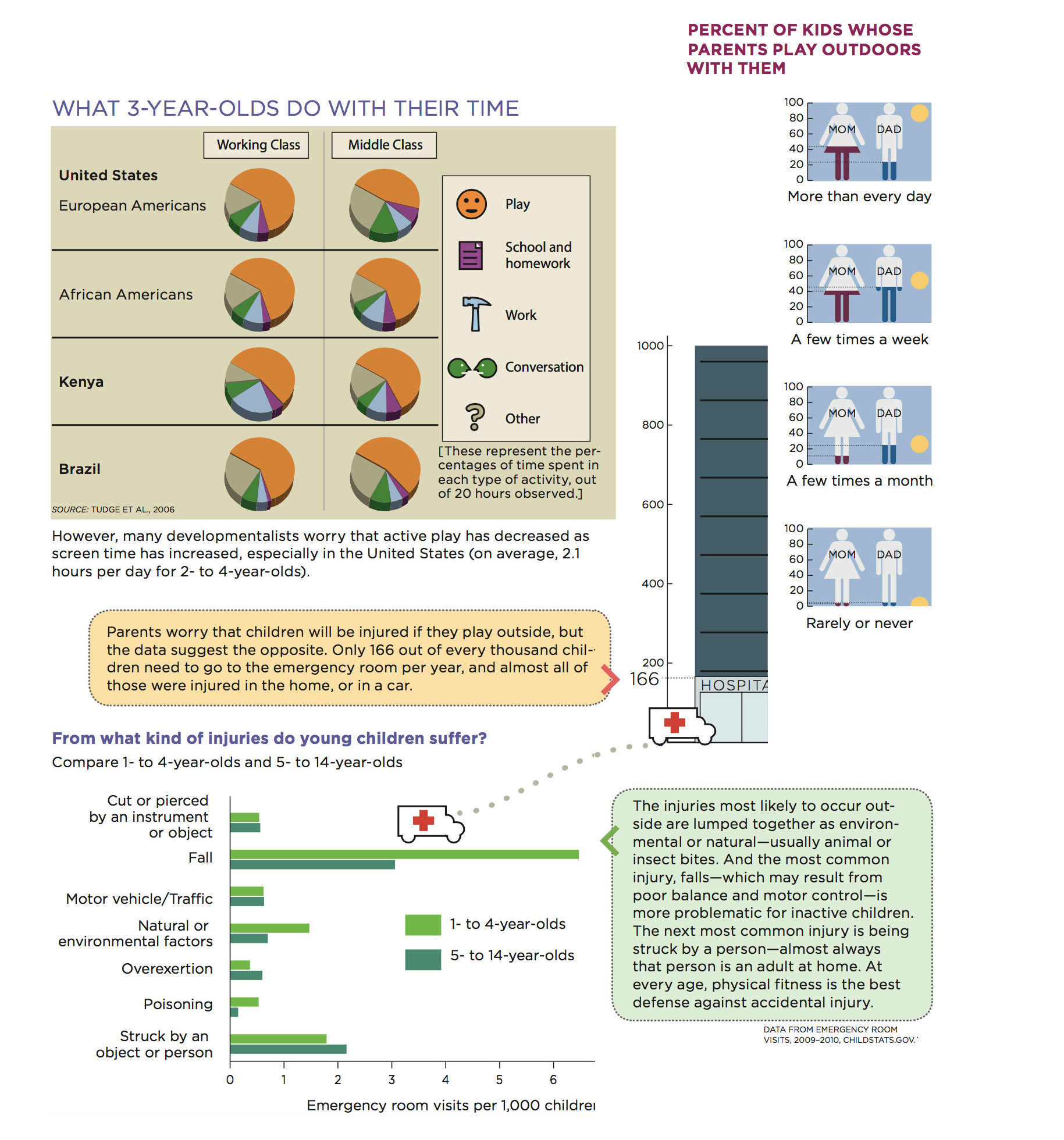
Playmates
How, then, should children play? Young children play best with peers, that is, people of about the same age and social status. Although even infants are intrigued by other small children, most infant play is either solitary or with a parent. Some maturation is required for social play, which may advance brain development and creativity (Bateson & Martin, 2013).
Such an advance can be seen over the years of early childhood. Toddlers are too self-
Parents have an obvious task: Find peers and arrange play dates. Of course, some parents play with their children, which benefits both of them. But even the most playful parent is outmatched by another child at negotiating the rules of tag, at play-
Culture and Cohort
All young children play; “everywhere, a child playing is a sign of healthy development” (Gosso, 2010, p. 95). Play is the favorite activity of young children, as illustrated in Visualizing Development, page 318. Basic play is similar in every culture: throwing and catching; chasing and exploring; pretending to be adults; drawing with chalk, felt pens, sticks, or anything that can make a mark. Accordingly, developmentalists think play is experience-
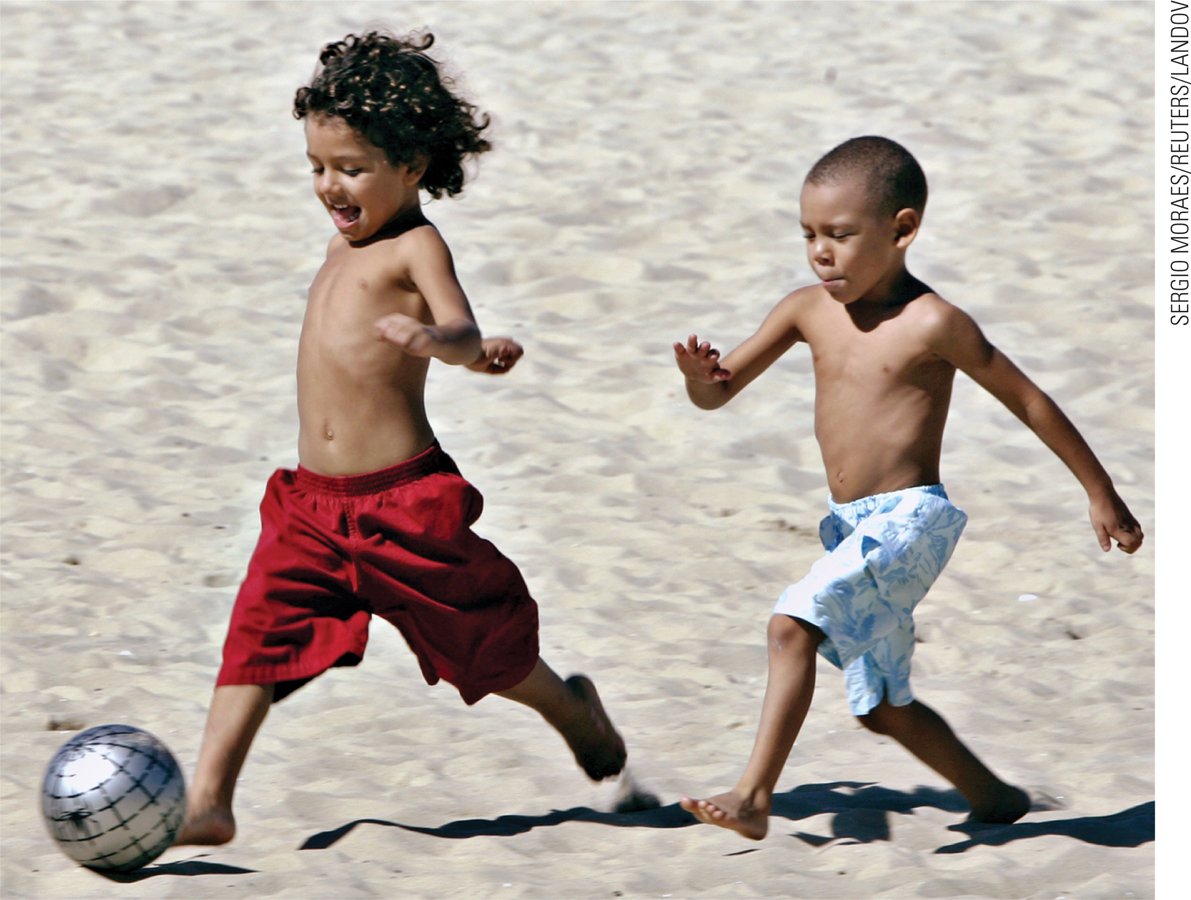
Some specifics are experience-
As children grow older, play becomes more social, influenced by brain maturation, playmate availability, and the physical setting. One developmentalist bemoans the twenty-
This opinion may be extreme, but it is echoed in more common concerns. As you remember, one dispute in preschool education is the proper balance between unstructured, creative play and teacher-
OBSERVATION QUIZ Does kicking a soccer ball, as shown above, require fine or gross motor skills?
Although controlling the trajectory of a ball with feet is a fine motor skill, these boys are using gross motor skills—
That was true in the United States a century ago. In 1932, the American sociologist Mildred Parten described the development of five kinds of social play, each more advanced than the previous one:
Solitary play: A child plays alone, unaware of any other children playing nearby.
Onlooker play: A child watches other children play.
Parallel play: Children play with similar objects in similar ways but not together.
Associative play: Children interact, sharing material, but their play is not reciprocal.
Cooperative play: Children play together, creating dramas or taking turns.
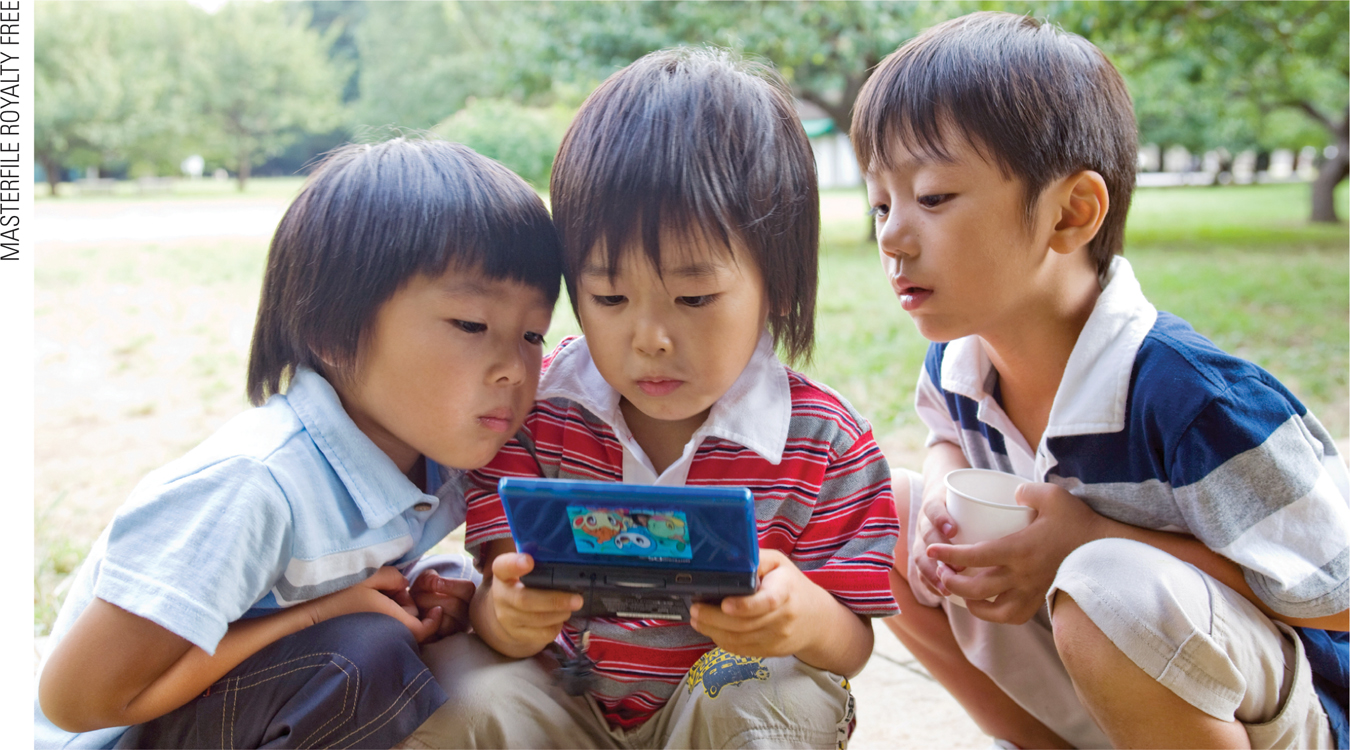
Parten thought that progress in social play was age-
Research on contemporary children finds much more age variation, perhaps because family size is smaller and parents invest heavily in each child. Many Asian parents teach 3-
Active Play
Children need physical activity to develop muscle strength and control. Peers provide an audience, role models, and sometimes competition. For instance, running skills develop best when children chase or race each other, not when a child runs alone. Gross motor play is favored among young children, who enjoy climbing, kicking, and tumbling (Case-
Active social play—
Active play advances planning and self-
Rough-and-Tumble Play
The most common form of active play is called rough-

If a young male monkey wanted to play, he would simply catch the eye of a peer and then run a few feet away. This invitation to rough-
When these scientists returned to London, they saw that their own children, like baby monkeys, engage in rough-
Rough-
Many scientists think that rough-
Drama and Pretending
Another major type of active play is sociodramatic play, in which children act out various roles and plots. Through such acting, children:
Explore and rehearse social roles
Learn to explain their ideas and persuade playmates
Practice emotional regulation by pretending to be afraid, angry, brave, and so on
Develop self-
concept in a nonthreatening context
Sociodramatic play builds on pretending, which emerges in toddlerhood. But preschoolers do more than pretend; they combine their imagination with that of their friends, advancing in theory of mind (Kavanaugh, 2011). The beginnings of sociodramatic play are illustrated by the following pair, a 3-
Boy: Not good. You bad.
Girl: Why?
Boy: ‘Cause you spill your milk
Girl: No. ‘Cause I bit somebody.
Boy: Yes, you did.
Girl: Say, “Go to sleep. Put your head down.”
Boy: Put your head down.
Girl: No.
Boy: Yes.
Girl: No.
Boy: Yes. Okay, I will spank you. Bad boy. [Spanks her, not hard]
Girl: No. My head is up. [Giggles] I want my teddy bear.
Boy: No. Your teddy bear go away.
[At this point she asked if he was really going to take the teddy bear away.]
[from Garvey, reported in Cohen, 2006, p. 72]
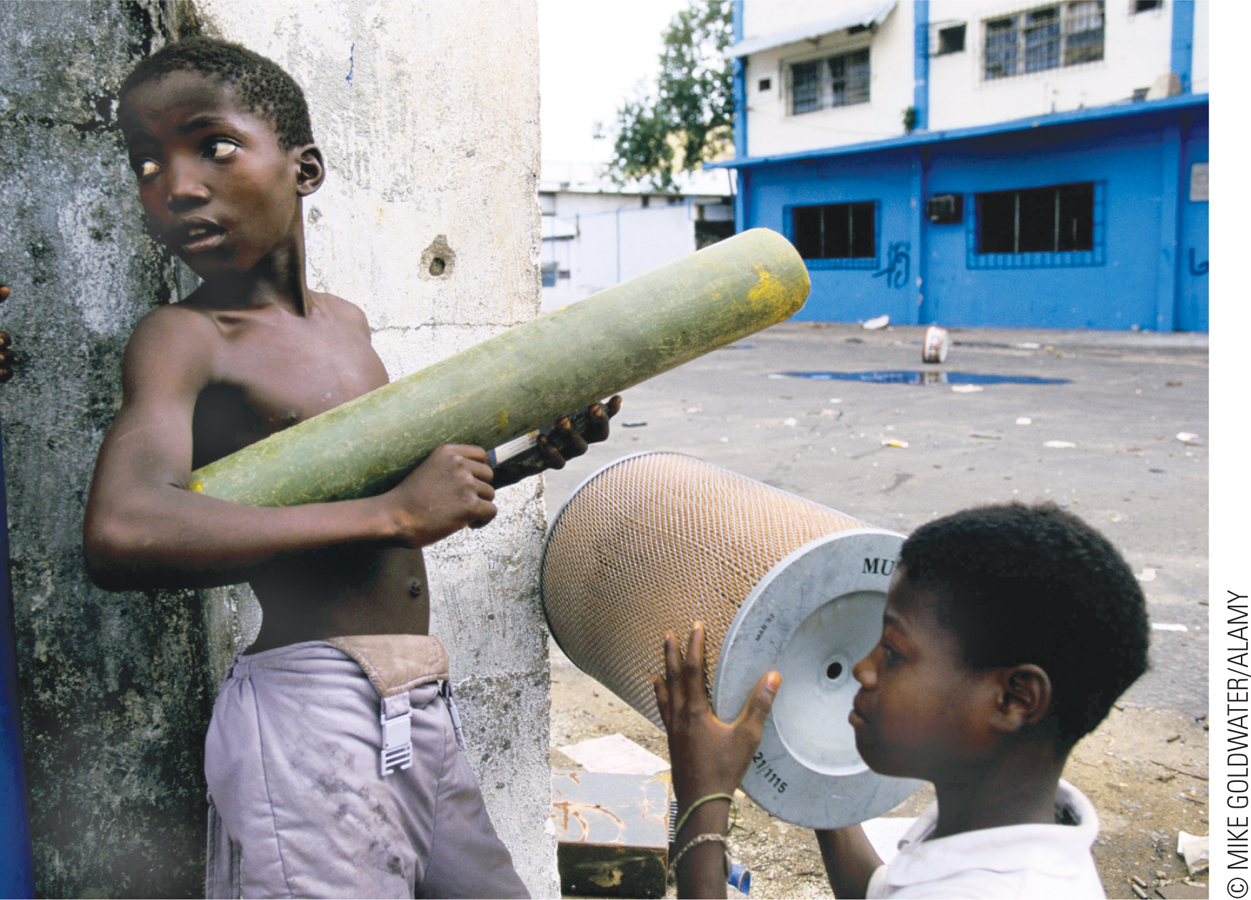
Note the social interaction in this form of play, with the 3-
A slightly older girl might want to play with the boys, but the older boys usually do not allow her (Pellegrini, 2013). Boy-
Older preschoolers are not only more gender-
Tuomas: And now he [Joni] would take me and would hang me…. This would be the end of all of me.
Joni: Hands behind.
Tuomas: I can’t help it. I have to. [The two other boys follow his example.]
Joni: I would put fire all around them.
[All three brave boys lie on the floor with hands tied behind their backs. Joni piles mattresses on them, and pretends to light a fire, which crackles closer and closer.]
Tuomas: Everything is lost.
[One boy starts to laugh.]
Petterl: Better not to laugh, soon we will all be dead…. I am saying my last words.
Tuomas: Now you can say your last wish…. And now I say I wish we can be terribly strong.
[At that point, the three boys suddenly gain extraordinary strength, pushing off the mattresses and extinguishing the fire. Good triumphs over evil, but not until the last moment, because, as one boy explains, “Otherwise this playing is not exciting at all.”]
[adapted from Kalliala, 2006, p. 83]
Good versus evil is a favorite theme of boys’ sociodramatic play, with danger part of the plot but victory in the end. By contrast, girls often act out domestic scenes, with themselves as the adults. In the same day-
The prevalence of sociodramatic play varies by culture, with parents often following cultural norms. Some cultures find make-
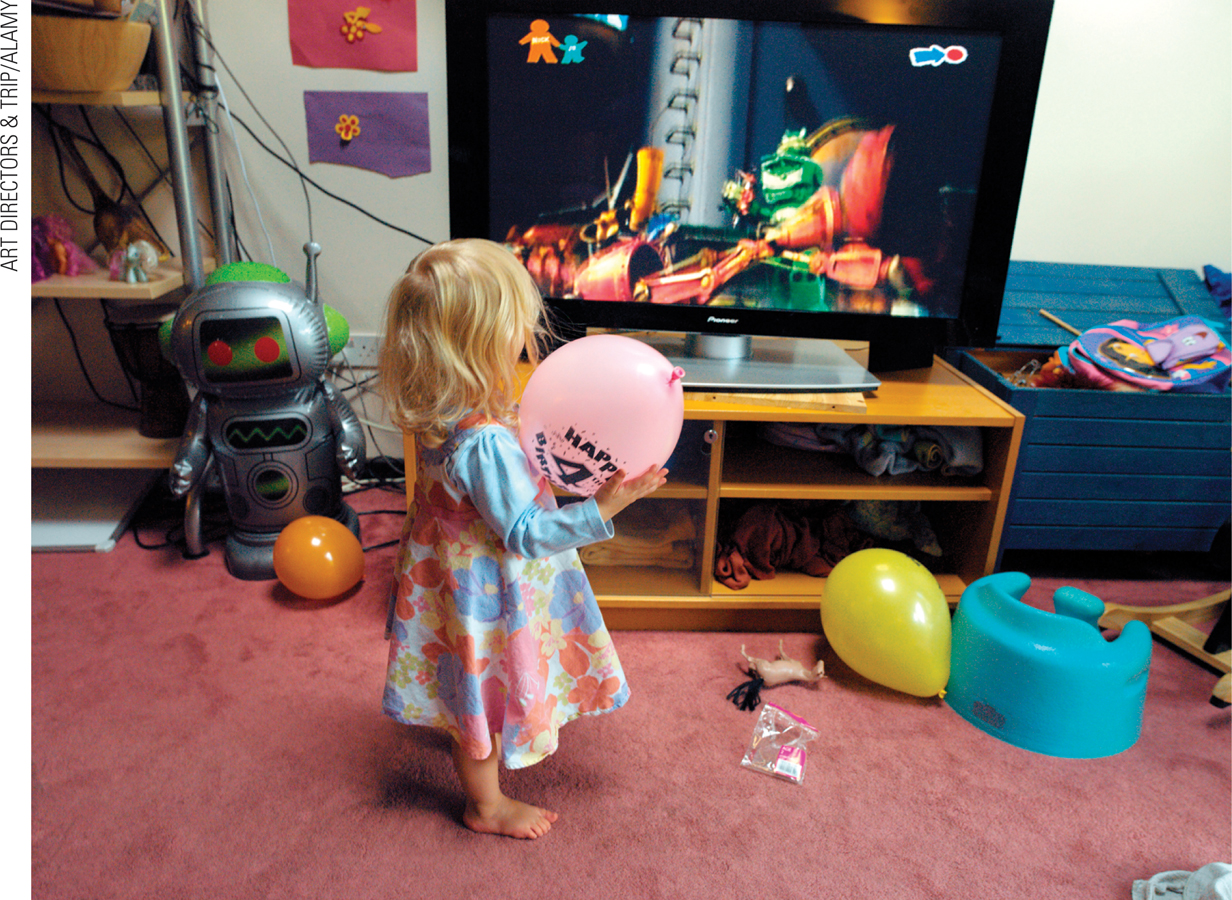
That children act out superheroes and villains from video screens is troubling to many developmentalists. They prefer prefer that children’s dramas come from their own imagination, not from the media. Of course, some children learn from videos, especially if adults watch with them and reinforce the lessons. However, children on their own rarely select educational programs over fast-
Canadian as well as U.S. organizations of professionals in child welfare (e.g., pediatricians) suggest children under age 2 have no screen time, and those over age 2 have less than an hour a day. However about half of all North American children exceed those limits, with screen time increasing as income falls (Carson et al., 2013; Fletcher et al., 2014). Professionals are concerned for many reasons: (1) violent media teaches aggression; (2) gender and ethnic stereotypes are pervasive; and (3) passive watching reduces time for family interaction and active play (see Figure 10.1).
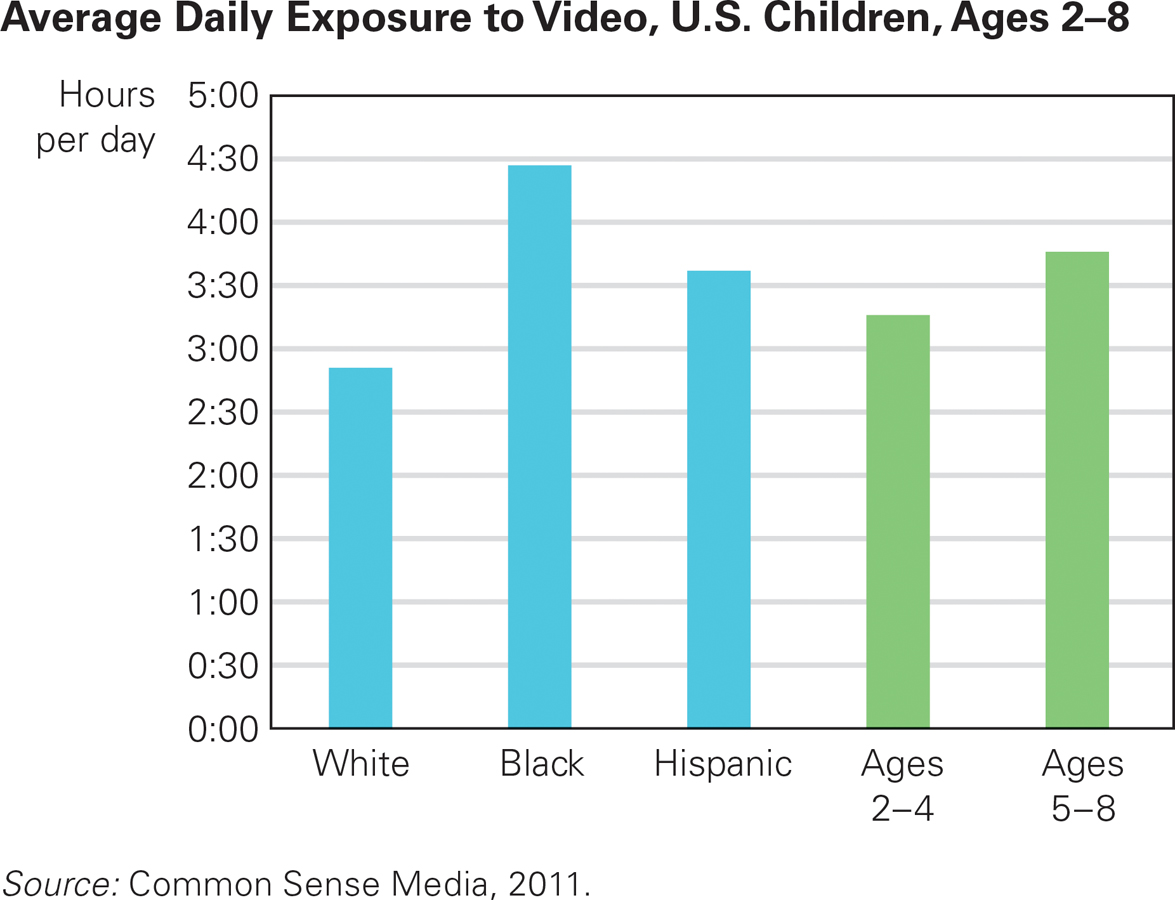
Learning by Playing Fifty years ago, the average child spent three hours a day in outdoor play. Video games and television have largely replaced that play time, especially in cities. Children seem safer if parents can keep an eye on them, but what are the long-

Video: The Impact of Media in Early ChildhoodMONKEY BUSINESS IMAGES/SHUTTERSTOCK
SUMMING UP As they have done in every era, all children everywhere play during early childhood, which makes many developmentalists think play is essential for healthy development. Some parents and other adults are not convinced; they would rather children help at home or learn academic skills.
Social play teaches social skills. In that way, at least, there is no doubt that children benefit from play with peers even more than from solitary play or play with adults. Specific games and dramas vary by culture and gender. Rough-
WHAT HAVE YOU LEARNED?
Question 10.8
What are children thought to gain from play?
Play is timeless and universal—apparent in every part of the world for thousands of years. Many developmentalists believe that play is the most productive as well as the most enjoyable activity that children undertake. There are two general kinds of play, pretend play that often occurs by a child alone, and social play, that occurs when children are together. The idea that pretend play is a crucial engine of child development has been explored in hundreds of studies and carefully reviewed. The reviewers do not confuse correlation with causation. They report that evidence is weak regarding pretend play, but they suggest that preventing social play will not only make children less happy, it may impair learning. They conclude that play— especially social play— is one way that children develop their minds and social skills, although not the only way. Question 10.9
Why might playing with peers help children build muscles and develop self-
control? Peers provide an audience, role models, and sometimes competition. For instance, running skills develop best when children chase or race each other, not when a child runs alone.Question 10.10
What do children learn from rough-
and- tumble play? Many scientists think that rough–and– tumble play helps the prefrontal cortex to develop, along with helping children learn to regulate emotions, practice social skills, and strengthen their bodies. Some believe that play in childhood, especially rough– and– tumble between a boy and his father, may prevent antisocial behavior later on. Question 10.11
What do children learn from sociodramatic play?
Through sociodramatic play, children learn to explore and rehearse social roles and to explain their ideas and convince playmates to agree. They also practice emotional regulation by pretending to be afraid, angry, brave, etc. and develop their self–concepts in a nonthreatening context. Question 10.12
Why do many experts want to limit children’s screen time?
Professionals are concerned for many reasons: (1) violent media teaches aggression; (2) gender and ethnic stereotypes are pervasive; and (3) passive watching reduces time for family interaction and active play.